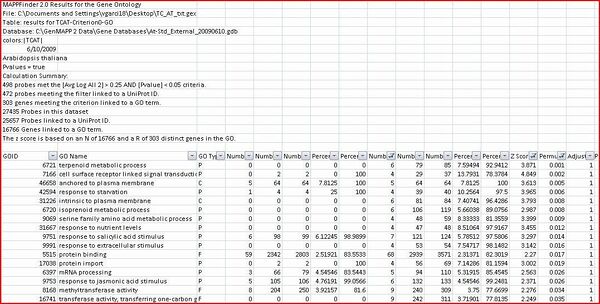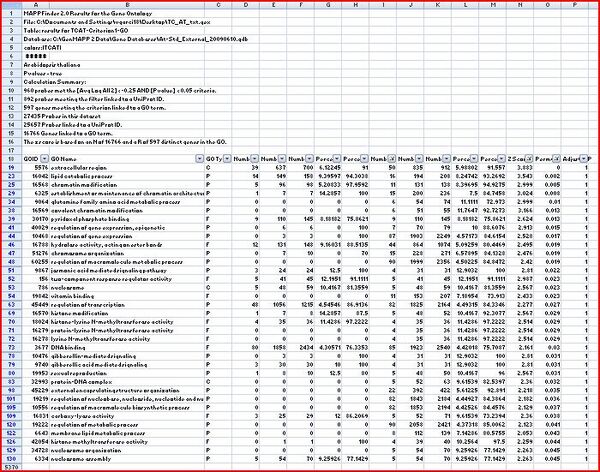Salomon Garcia: Week 13
From OpenWetWare
Jump to navigationJump to search
Procedure for Analysis
- The analysis of the data has been done and now we are reaching the second step of the process for our presentation.
- The program Genmapp was used for this portion of the experiment we found a total of 1778 errors in the genes
- These were some of the results gathered from Genmapp:(These files are in txt. format)
- Once the data was acquired than this data was filtered using excel.
- These were the parameters used in order to filter:
- Permute P-value <0.05
- Z score > 2
- Number changed > 3 < 100
- Percent changed: no percent changed
- Here are the two files for the Increase and Decrease:(These files are in xls 97-2003 format)
This is a view of the excel and how it was filtered:


Top 15 Geneontolgy for Criterion0 (Increased)
- terpenoid metabolic process- The chemical reactions and pathways involving terpenoids, any member of a class of compounds characterized by an isoprenoid chemical structure and including derivatives with various functional groups.
- cell surface receptor linked signal transduction- Any series of molecular signals initiated by the binding of an extracellular ligand to a receptor on the surface of the target cell.
- anchored to plasma membrane- Tethered to the plasma membrane by a covalently attached anchor, such as a lipid moiety, that is embedded in the membrane. When used to describe a protein, indicates that the peptide sequence does not span the membrane.
- response to starvation- A change in state or activity of a cell or an organism (in terms of movement, secretion, enzyme production, gene expression, etc.) as a result of a starvation stimulus, deprivation of nourishment.
- intrinsic to plasma membrane- Located in the plasma membrane such that some covalently attached portion of the gene product, for example part of a peptide sequence or some other covalently attached moiety such as a GPI anchor, spans or is embedded in one or both leaflets of the membrane.
- isoprenoid metabolic process- The chemical reactions and pathways involving isoprenoid compounds, isoprene (2-methylbuta-1,3-diene) or compounds containing or derived from linked isoprene (3-methyl-2-butenylene) residues.
- serine family amino acid metabolic process- The chemical reactions and pathways involving amino acids of the serine family, comprising cysteine, glycine, homoserine, selenocysteine and serine.
- response to nutrient levels- A change in state or activity of a cell or an organism (in terms of movement, secretion, enzyme production, gene expression, etc.) as a result of a stimulus reflecting the presence, absence, or concentration of nutrients.
- response to salicylic acid stimulus- A change in state or activity of a cell or an organism (in terms of movement, secretion, enzyme production, gene expression, etc.) as a result of a salicylic acid stimulus.
- response to extracellular stimulus- A change in state or activity of a cell or an organism (in terms of movement, secretion, enzyme production, gene expression, etc.) as a result of an extracellular stimulus.
- protein binding- Interacting selectively and non-covalently with any protein or protein complex (a complex of two or more proteins that may include other nonprotein molecules).
- protein import- The directed movement of proteins into a cell or organelle.
- mRNA processing- Any process involved in the conversion of a primary mRNA transcript into one or more mature mRNA(s) prior to translation into polypeptide.
- response to jasmonic acid stimulus- A change in state or activity of a cell or an organism (in terms of movement, secretion, enzyme production, gene expression, etc.) as a result of a jasmonic acid stimulus.
- methyltransferase activity- Catalysis of the transfer of a methyl group to an acceptor molecule.
Top 15 Geneontology for Criterion1 (Decreaased)
- Extracellular region- The space external to the outermost structure of a cell. For cells without external protective or external encapsulating structures this refers to space outside of the plasma membrane. This term covers the host cell environment outside an intracellular parasite.
- Lipid catabolic process- The chemical reactions and pathways resulting in the breakdown of lipids, compounds soluble in an organic solvent but not, or sparingly, in an aqueous solvent.
- Chromatin modification- The alteration of DNA or protein in chromatin, which may result in changing the chromatin structure.
- Establishment or maintenance of chromatin architecture- Any process that results in the specification, formation or maintenance of the physical structure of eukaryotic chromatin.
- glutamine family amino acid metabolic process- The chemical reactions and pathways involving amino acids of the glutamine family, comprising arginine, glutamate, glutamine and proline.
- covalent chromatin modification- The alteration of DNA or protein in chromatin by the covalent addition or removal of chemical groups.
- pyridoxal phosphate binding- Interacting selectively and non-covalently with pyridoxal 5' phosphate, 3-hydroxy-5-(hydroxymethyl)-2-methyl4-pyridine carboxaldehyde 5' phosphate, the biologically active form of vitamin B6.
- regulation of gene expression, epigenetic- Any process that modulates the frequency, rate or extent of gene expression; the process is mitotically or meiotically heritable, or is stably self-propagated in the cytoplasm of a resting cell, and does not entail a change in DNA sequence.
- regulation of gene expression- Any process that modulates the frequency, rate or extent of gene expression. Gene expression is the process in which a gene's coding sequence is converted into a mature gene product or products (proteins or RNA). This includes the production of an RNA transcript as well as any processing to produce a mature RNA product or an mRNA (for protein-coding genes) and the translation of that mRNA into protein. Some protein processing events may be included when they are required to form an active form of a product from an inactive precursor form.
- hydrolase activity, acting on ester bonds- Catalysis of the hydrolysis of any ester bond.
- chromosome organization- A process that is carried out at the cellular level that results in the assembly, arrangement of constituent parts, or disassembly of chromosomes, structures composed of a very long molecule of DNA and associated proteins that carries hereditary information
- regulation of macromolecule metabolic process- Any process that modulates the frequency, rate or extent of the chemical reactions and pathways involving macromolecules, any molecule of high relative molecular mass, the structure of which essentially comprises the multiple repetition of units derived, actually or conceptually, from molecules of low relative molecular mass
- jasmonic acid mediated signaling pathway- A series of molecular signals mediated by jasmonic acid.
- two-component response regulator activity- Alters the level of transcription of target genes, usually by binding to a transcription factor, when phosphorylated by a sensor that detects the presence of a particular signal substance outside the cell.
- nucleosome- A complex comprised of DNA wound around a multisubunit core and associated proteins, which forms the primary packing unit of DNA into higher order structures.
This is folder containing all of the necessary information for the final presentation it has the mapp: (I've downloaded the folder as zip)
Folder for final presentation
BIOL 398-01: Bioinformatics Lab
- Lab Journal
- Shared Journal
- BIOL398-01/S10:Class Journal Week 2
- BIOL398-01/S10:Class Journal Week 3
- BIOL398-01/S10:Class Journal Week 4
- BIOL398-01/S10:Class Journal Week 5
- BIOL398-01/S10:Class Journal Week 6
- BIOL398-01/S10:Class Journal Week 7
- BIOL398-01/S10:Class Journal Week 8
- BIOL398-01/S10:Class Journal Week 9
- BIOL398-01/S10:Class Journal Week 11
- BIOL398-01/S10:Class Journal Week 12
- BIOL398-01/S10:Class Journal Week 13
- BIOL398-01/S10:Class Journal Week 14
- Assignments
- BIOL398-01/S10:Week 2
- BIOL398-01/S10:Week 3
- BIOL398-01/S10:Week 4
- BIOL398-01/S10:Week 5
- BIOL398-01/S10:Week 6
- BIOL398-01/S10:Week 7
- BIOL398-01/S10:Week 8
- BIOL398-01/S10:Week 9
- BIOL398-01/S10:Week 11
- BIOL398-01/S10:Week 12
- BIOL398-01/S10:Week 13
- BIOL398-01/S10:Week 14